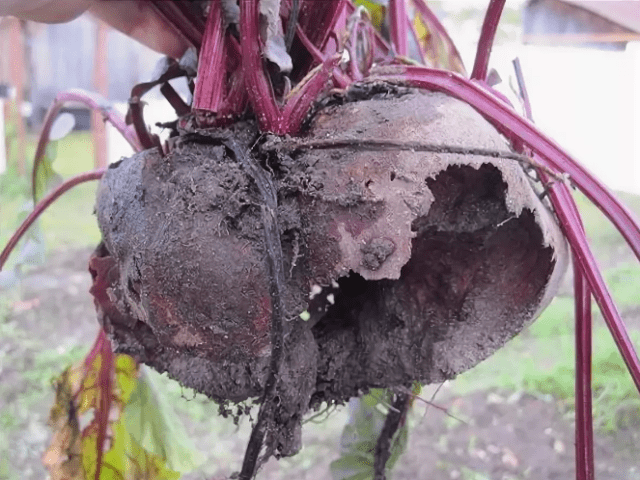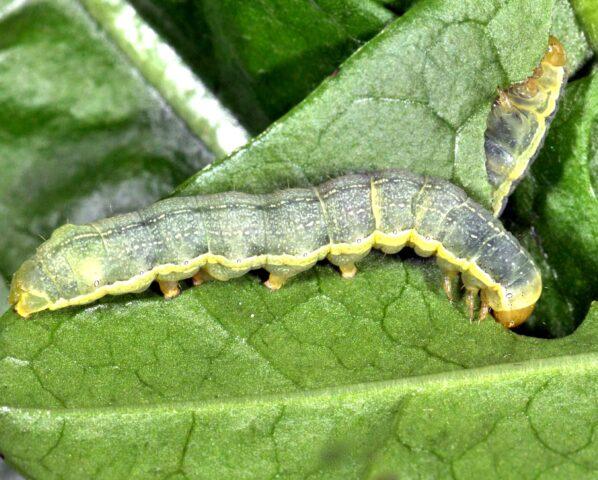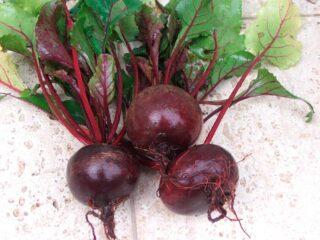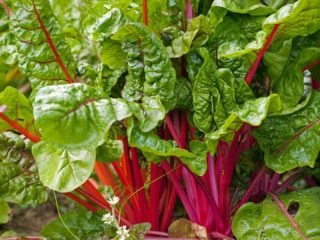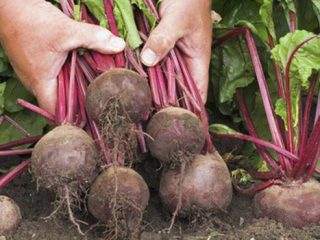Content
The variety of beet varieties bred by Russian and foreign breeders allows gardeners to choose both promising novelties and reliable, time-tested options. The latter include the Detroit beet, which was bred more than 25 years ago, but still retains popularity due to its undoubted advantages.
Origin story
Despite the name, Detroit beets have nothing to do with the United States. Her homeland is Italy. The variety was bred by breeders of Zorzi Sementi SRL in the early 90s.
Russian gardeners met him in 1994. Three years later, Detroit beetroot was included in the State Register of Breeding Achievements at the request of a group of agricultural firms.
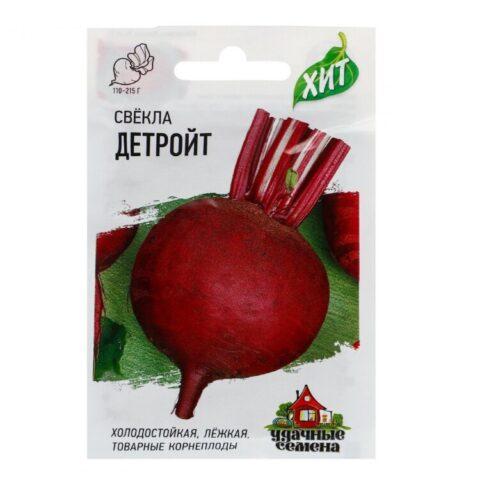
Detroit beet seeds are produced by different producers
The variety is recognized as the most suitable for planting in the Central region. But the experience of gardeners living in other areas shows that he successfully adapts to the most varied features of the local climate.
Description and characteristics of the Detroit beet variety
Detroit is a mid-season beetroot. It takes 85-105 days for the ripening of root crops from the moment the shoots emerge from the seeds. The specific dates depend on how lucky the gardener is with the weather during the summer. The variety is officially recommended not only for cultivation on personal plots for personal consumption, but also for cultivation by farms.
The rosette of the Detroit variety is semi-vertical, relatively compact, of medium height. The leaves are not large, although there are a lot of them. The surface of the leaf plate is almost even, with a weakly pronounced "bubbling" and slightly wavy edges. Root crops of the correct, rounded shape, with a smooth skin of a typical "beetroot" color. The root is very thin and short.
Root crops ripen in different sizes. The weight of Detroit beets varies between 110-215 g. The yield is quite high - 9-10 kg / m².
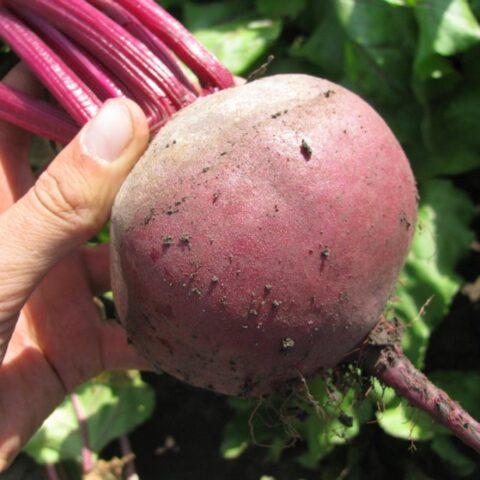
Most (82-91%) - presentation
The pulp is a rich burgundy-red hue, without light "rings" and "veins". It is very juicy, dense, homogeneous in texture, but at the same time tender. The characteristic sweetish aftertaste is well discernible. It is explained by the fact that the percentage of sugar content in Detroit beets is higher than that of many others - 12.3-14.2%.
Gardeners appreciate it for its overall "stress tolerance". This variety successfully adapts to a wide range of not always favorable climatic conditions, the impact of negative environmental factors. Seedlings do not suffer from recurrent spring frosts, small negative temperatures. Detroit beets are also suitable for planting before winter, in spring the seeds germinate en masse.
Also, Detroit beets have a high dry matter content (17.6-20.4%). This explains its transportability and keeping quality. Root crops are stored at least until the end of winter (often until the beginning of the next season), keeping the texture of the pulp and taste.
The purpose of the variety is universal. Detroit beets are widely used in cooking, fresh and boiled for salads, appetizers, first and second courses. You can squeeze juice from it, use it as an ingredient in homemade preparations for the winter.
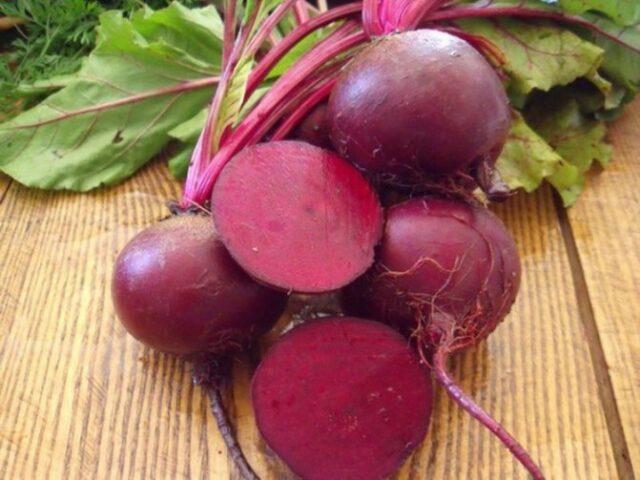
After heat treatment, Detroit beets retain their rich pulp color and most of the health benefits
Varieties
Detroit beets seemed so successful to breeders that they used them as a "base" for further experiments. As a result, several varieties have emerged.
Detroit Dark Red
It differs from the "original" in early maturity and increased sugar content. The weight of root crops varies even more - in the range of 80-250 g.
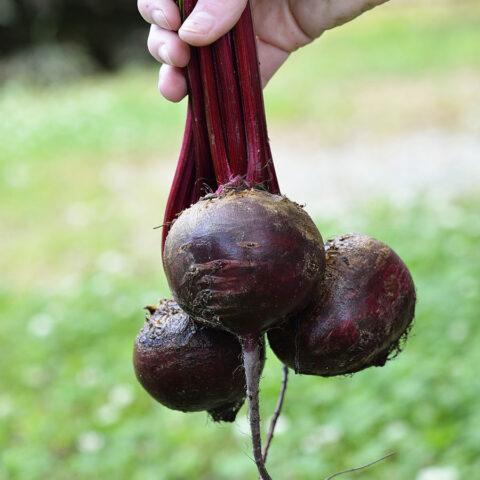
Detroit Dark Red beets are recommended for fresh consumption and juicing
Detroit 6 Rubidus
Also an early variety. It tolerates frosts, low temperatures during the growing season and lack of light better than the "classic" Detroit beets.
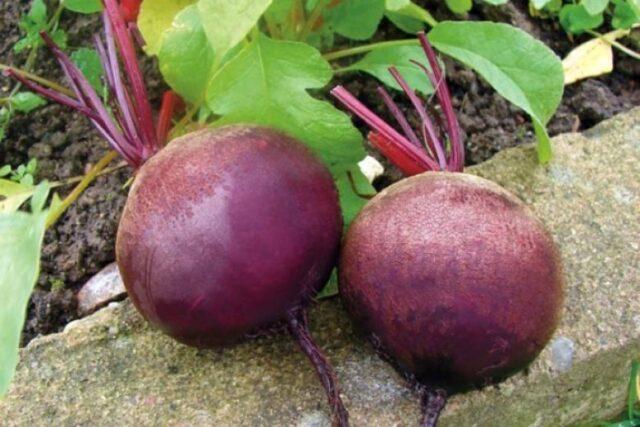
Detroit 6 Rubidus beets are relatively one-dimensional, weighing 120-150 g
Detroit 2 Nero (Detroit 2 Nero)
A medium late ripening variety with a higher yield than ordinary Detroit beets (10-12 kg / m²). Root crops are almost one-dimensional (140-160 g), regular, rounded.

Detroit 2 Nero beet pulp does not accumulate nitrates, even if you overdo it with nitrogen fertilizers
Advantages and disadvantages
The popularity of Detroit beets among amateur gardeners and professional farmers is easily explained by its significant advantages:
- the stability of fruiting, despite the vagaries of the weather in summer;
- presentable appearance of root crops;
- uniform pulp texture;
- excellent taste and versatility of the purpose;
- the ability to withstand recurrent spring frosts, summer heat, drought;
- very good immunity;
- keeping quality and transportability;
- resistance to flowering and shooting;
- massive "friendly" fruiting;
- consistently high seed germination and percentage of marketable fruits during harvest;
- general undemanding care.
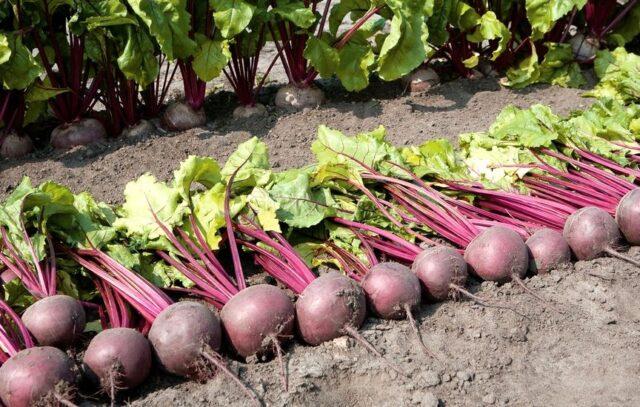
Detroit beet growers almost always stay with their crops
Of the relative disadvantages - only the relatively small size of root crops. But many people like just such varieties - they are more convenient to store.
When to plant
In central Russia, Detroit beet seeds are planted in beds at the end of April or in the first decade of May, when the average daily temperature is set at 12-15 ° C. In regions with a warmer or harsher climate, the dates are shifted by 2-3 weeks, respectively, back or forward.
If a seedling method of growing a crop is chosen, the seeds of the house are sown 4-5 weeks before the expected date of planting in the ground.
Beet planting methods Detroit
Like any beet, Detroit can be grown both by seedling and by sowing seeds directly in the garden. But the practice of Russian gardeners shows that the first method (by the way, requiring a lot of time and effort) is not very suitable for this variety. After transplanting to the beds, the seedlings adapt for a long time to the new habitat. As a result, these plants lag behind in development from those that were grown in the open field from seeds and form smaller roots.
Seedling growing method
Detroit beet seedlings are grown according to the following algorithm:
- Pickle the seeds in a solution of any fungicide or potassium permanganate (bright pink) to prevent fungal diseases.
- Plant them in boxes, containers filled with universal soil for seedlings or a mixture of black soil with peat crumbs and sand (2: 1: 1), having previously well moistened and leveled the substrate. Seeds are sown one at a time to a depth of about 1.5 cm, leaving 2-2.5 cm between them, and 3.5-4 cm between rows.
- Before the emergence of Detroit beetroot shoots (it takes 7-10 days), cover the container with plastic wrap, glass, and put it in a dark, warm place.It is necessary to control the condition of the soil, not allowing it to dry out completely, and daily ventilate the "greenhouse" so that condensation does not accumulate in it.
- Transfer the seedlings to the light. In the phase of the first true leaf, thin out the plantings, leaving 3-4 cm between adjacent specimens.At the same time, you can feed them with any fertilizer for seedlings based on vermicompost, but this is an optional step. Only timely watering is vital for Detroit beet seedlings.
- In the phase of the third true leaf, plant the seedlings in the ground with an interval of 15-20 cm and a row spacing of 30-35 cm. Water the garden bed well (20-25 l / m²) first. Mulch the soil. In the first 7-10 days after transplanting at night, it is better to cover the soil with plastic wrap or dark covering material.
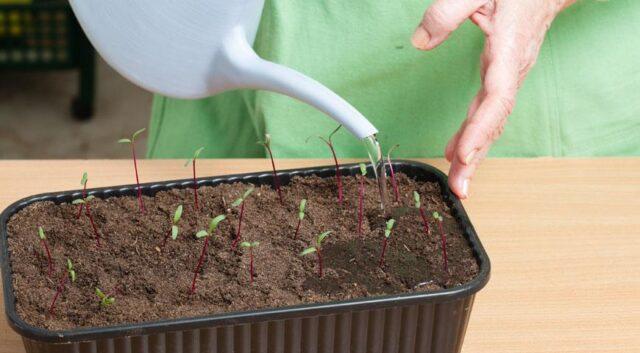
If the soil in the container dries up, the seedlings will die.
Seed in open ground
Disembarkation is preceded by the choice of a place for the garden. Detroit beets are undemanding to growing conditions, but it must be borne in mind that an ideal site for it meets several criteria:
- good illumination;
- the presence of protection from strong winds, drafts;
- neutral or slightly acidic soil, this is the main "requirement": in an alkaline or acidified substrate, Detroit beets will simply die;
- the nutritional value of the soil, combined with water and air permeability (sandy loam, loam);
- suitable "predecessors" (all crops from the families Pumpkin, Solanaceae, Legumes, onions, garlic, herbs).
Since the fall, the selected bed is dug up, humus (3-5 l / m²) and complex phosphorus-potassium fertilizer (20-25 g / m²) are added. If necessary - other substances to ensure the required acid-base balance.
Detroit beet seeds need pre-planting preparation. The easiest way is to soak them for a day in warm (40-45 ° C) water. It needs to be changed periodically to maintain the temperature. Another way is to wrap them in a damp cloth, a napkin (it should not be allowed to dry out), put on a saucer and put it closer to the radiator.
Before planting beet seeds, Detroit is well loosened, the soil is moistened and leveled. They are planted to a depth of 3-4 cm, if possible one at a time, with an interval of about 15 cm. The minimum row spacing is 30 cm. If you sow seeds uncontrollably, then planting will have to be thinned out.
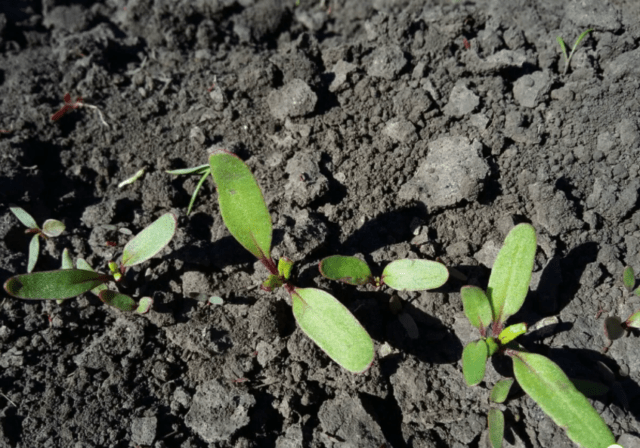
Beets are thinned out, cutting off "unnecessary" seedlings, so as not to damage the roots of those that are left in the garden
Beet Care Detroit
Even novice gardeners can take care of Detroit beets:
- Watering. Until the formation of root crops, water the garden bed every 2-3 days, preventing the soil from completely drying out. Then switch to weekly watering, consuming about 15-20 l / m². Of course, the intervals are adjusted taking into account natural precipitation and air temperature. One month before harvest, it is important to stop watering altogether.
- Loosening and weeding. Spend the next day after watering. It is impossible to let the soil in the garden "bake" into a hard crust that does not allow water and oxygen to reach the roots.
- Mulching. An optional but very useful agronomic measure. If you mulch the garden right after the Detroit beet is planted, it can be watered less frequently later. Mulch also saves time on loosening and weeding.
- Thinning. Only required for uncontrolled planting of Detroit beet seeds. It is carried out twice - in the phase of the 2-3rd and 5-6th true leaf. The most powerful and developed plants are left on the garden bed, keeping an interval between them, respectively, 3-4 cm and 7-8 cm.
- Top dressing.In the phase of the 2-3rd true leaf, the best option is any fertilizer based on natural organic matter to stimulate the growth of green mass. Then, approximately in the middle of the growing season, a complex top dressing is introduced for root crops or especially for beets. An excess of fertilizer provokes the appearance of cracks and voids in the roots of Detroit beets.

Sometimes Detroit beets can get by with natural rainfall during the season.
Possible diseases and pests
Detroit beets rarely suffer from fungal diseases. But if it is thickened in the garden in damp cool weather, it can still become infected with powdery mildew or gray rot.
In both cases, plaque appears on the plant. But in the first it is whitish, powdery, and in the second it is silvery-gray, fluffy, with small black blotches. Gradually, this plaque thickens, the affected tissues rot or dry out, holes are formed.

Powdery mildew can affect almost any garden crop
Any fungicides will help to cope with a pathogenic fungus. Both the plants themselves and the soil in the garden are sprayed with solutions. But it must be remembered that if there is less than a month left before the harvest of Detroit beets, only preparations of biological origin can be used.
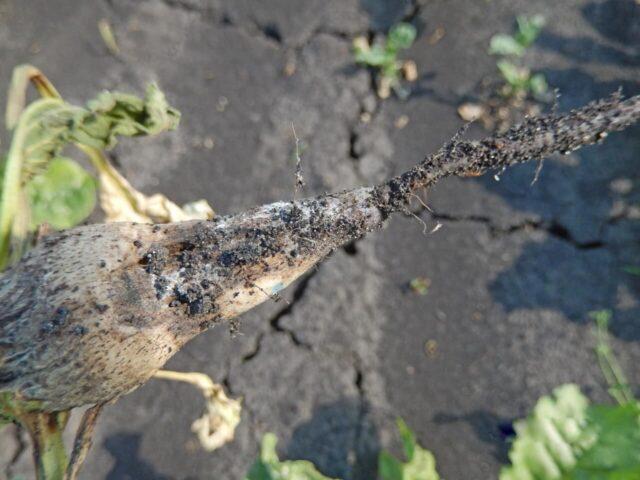
Beets heavily affected by gray rot are best pulled out and burned
Of the pests, the most dangerous are:
- Medvedki. Insects leading an underground lifestyle, moving, gnaw holes in the roots or "cut" the roots of seedlings.
Beets damaged by beets are clearly unsuitable for food
- Caterpillars of a butterfly butterfly. They feed very actively on the aerial part of the plant, leaving only petioles and veins from the leaves in a few days.
The caterpillars of the scoop are distinguished by their rare gluttony.
To scare away the bear from the beds with Detroit beets, granules of special preparations (for example, Medvetox) are added to the soil during planting. Prophylactic treatments with any universal insecticides are effective against adults and caterpillars of the scoop. They are also used if a pest attack could not be avoided.
Conclusion
Detroit beets are suitable for beginners, experienced gardeners and professional farmers alike. Consistently high yield and taste of root crops are very successfully combined with non-capricious care, the ability to tolerate lower temperatures during the growing season without prejudice to oneself, and good immunity. The transportability and keeping quality of Detroit beets make it possible to preserve the harvest for a long time without any problems.
Reviews of gardeners about beets Detroit
